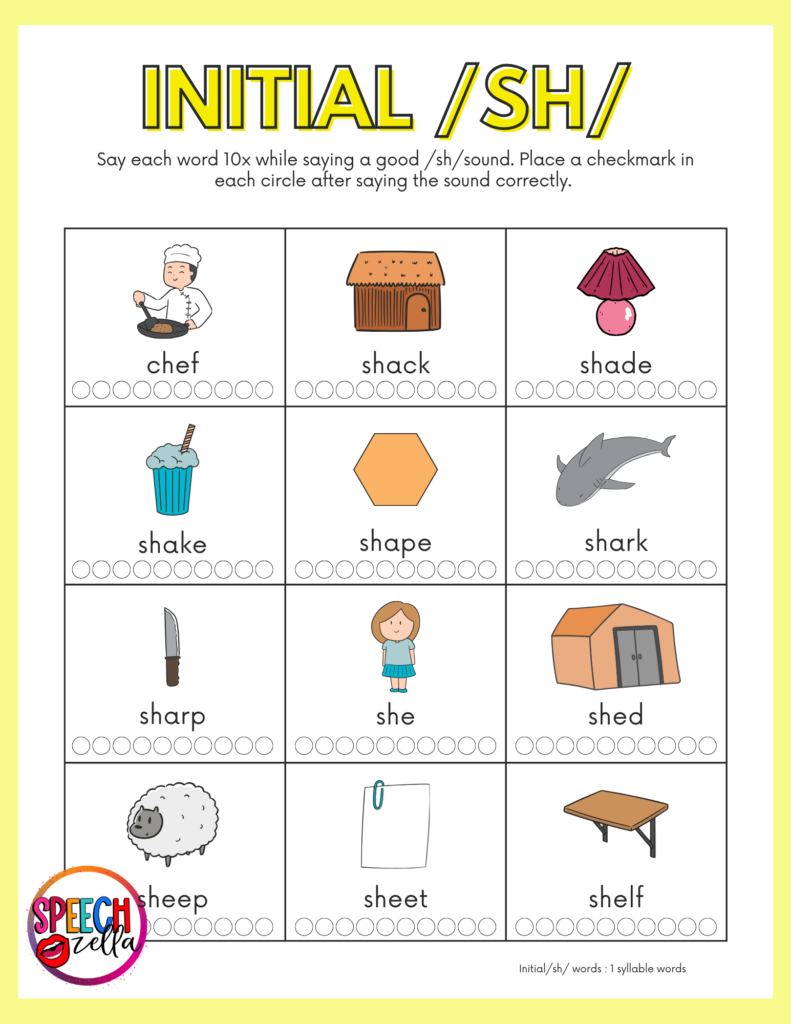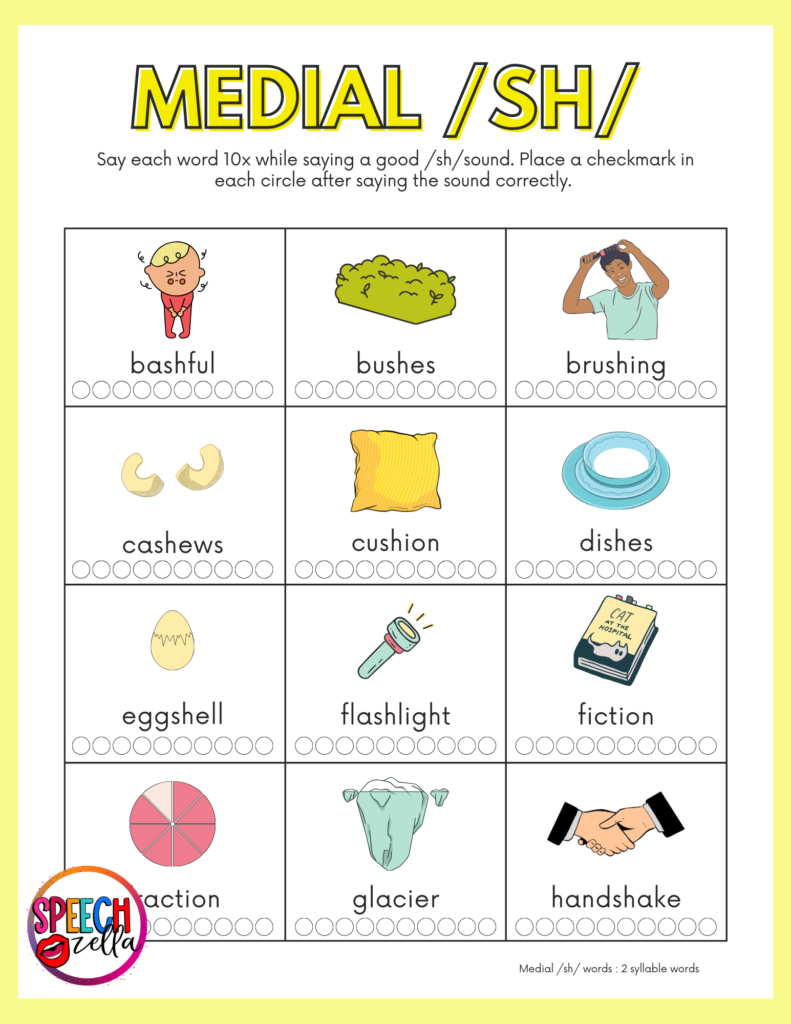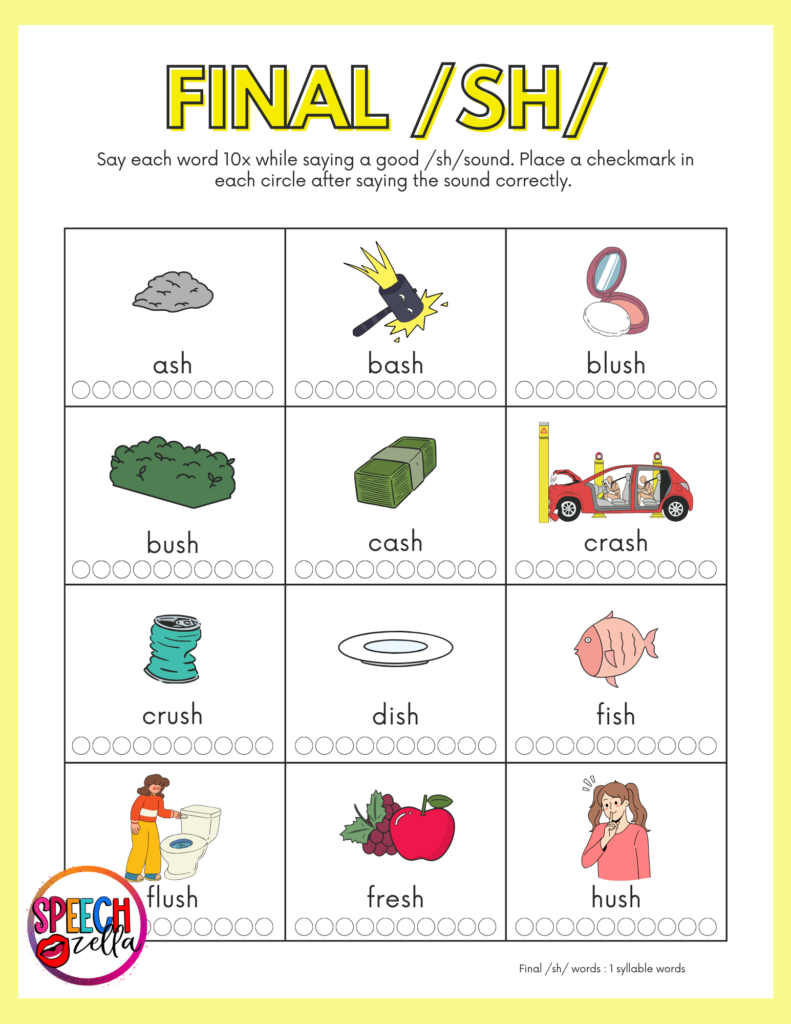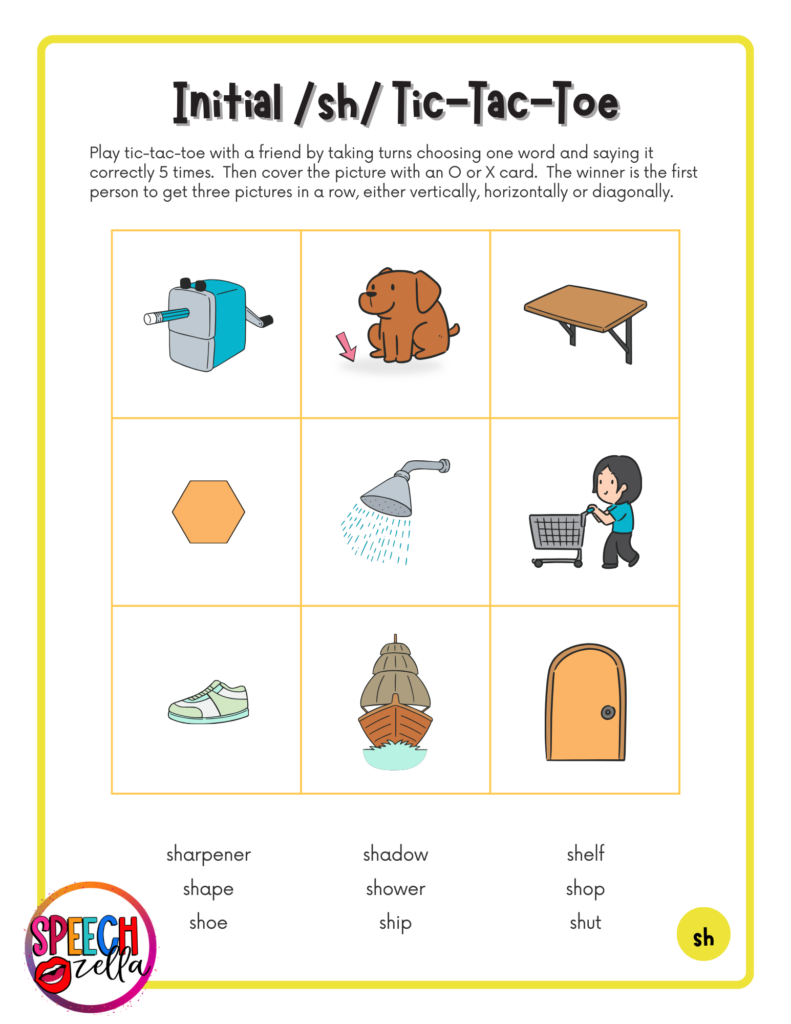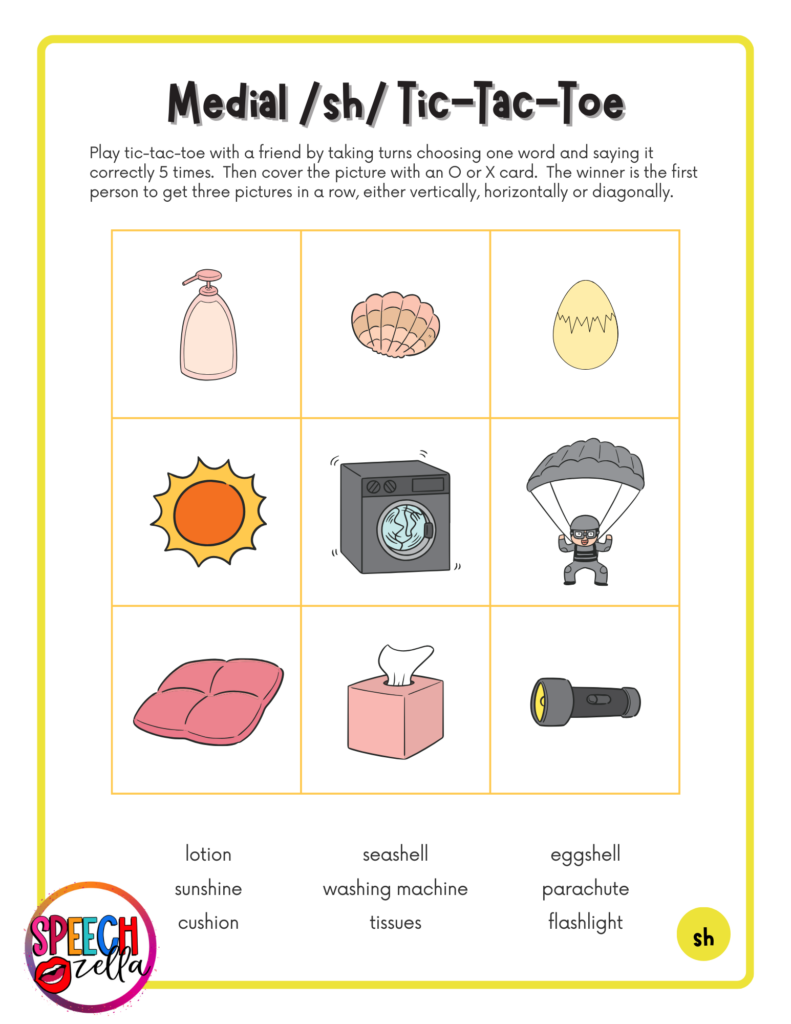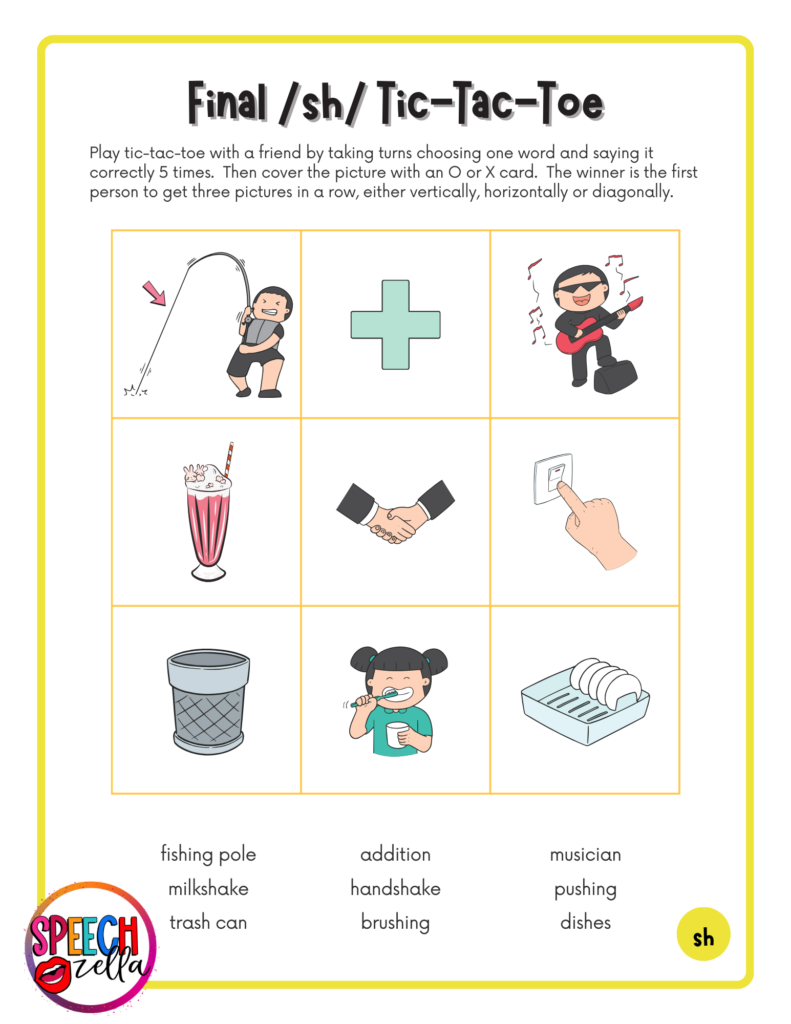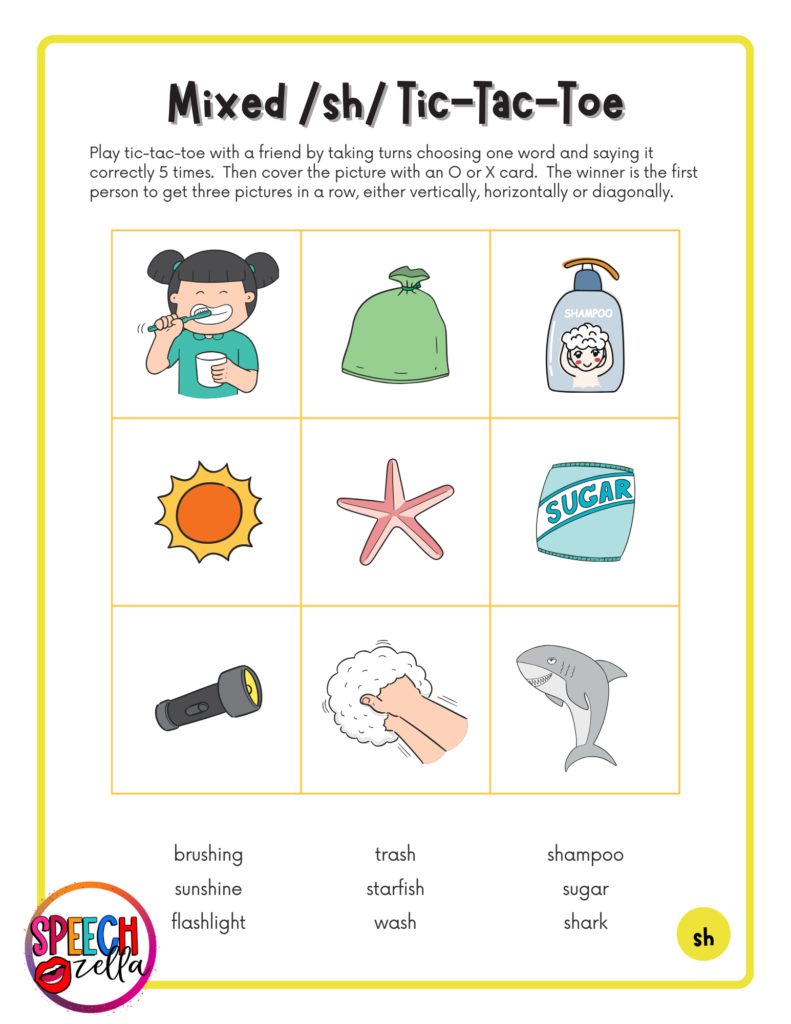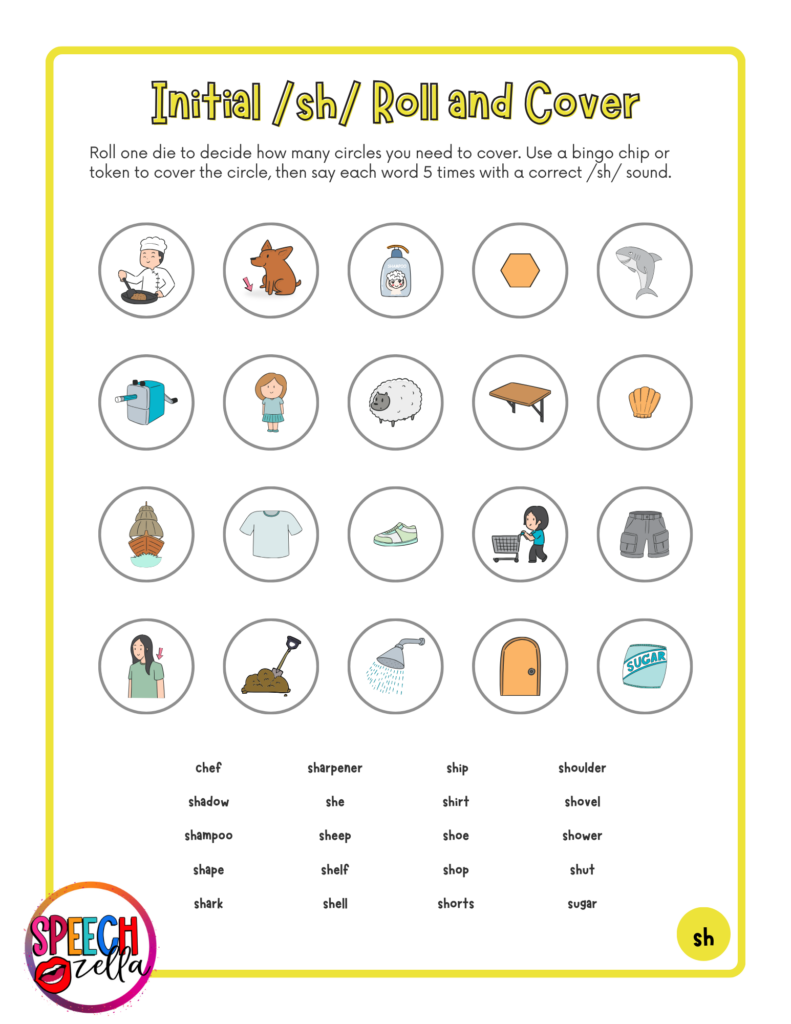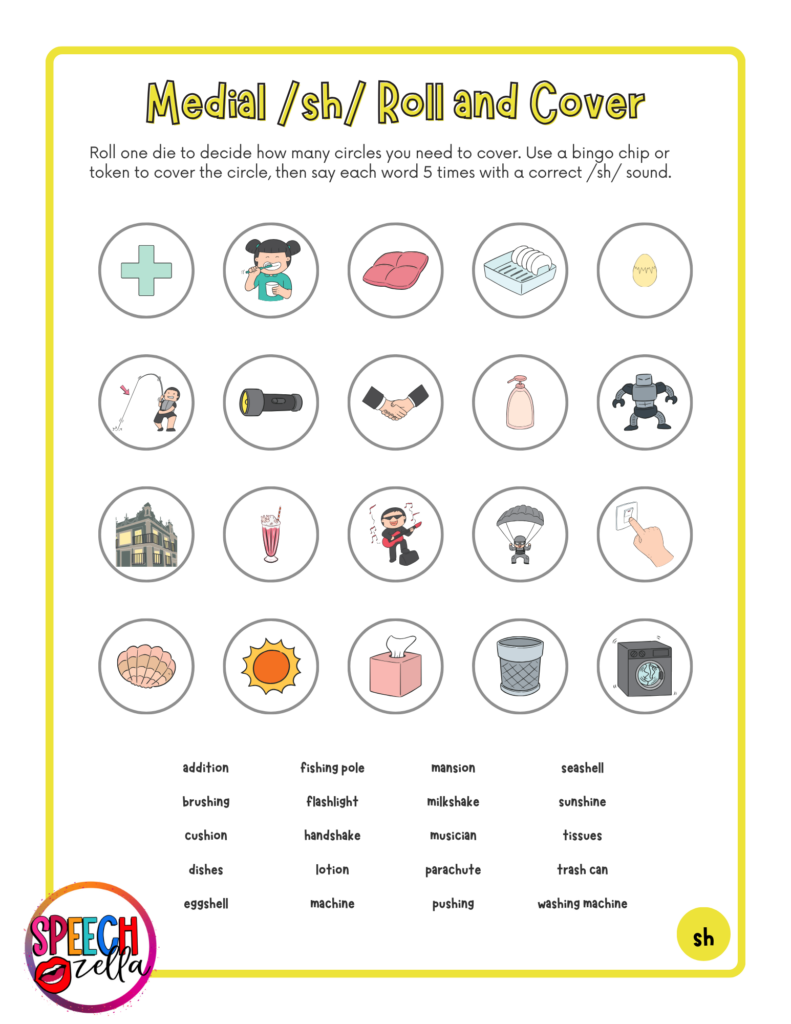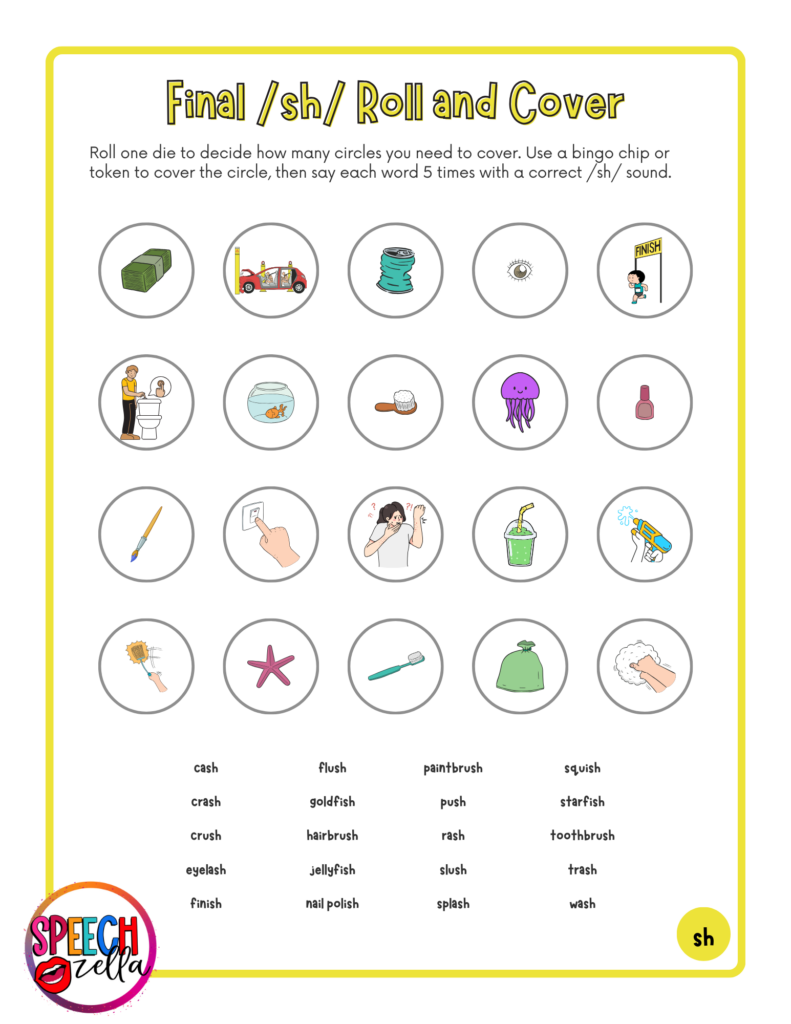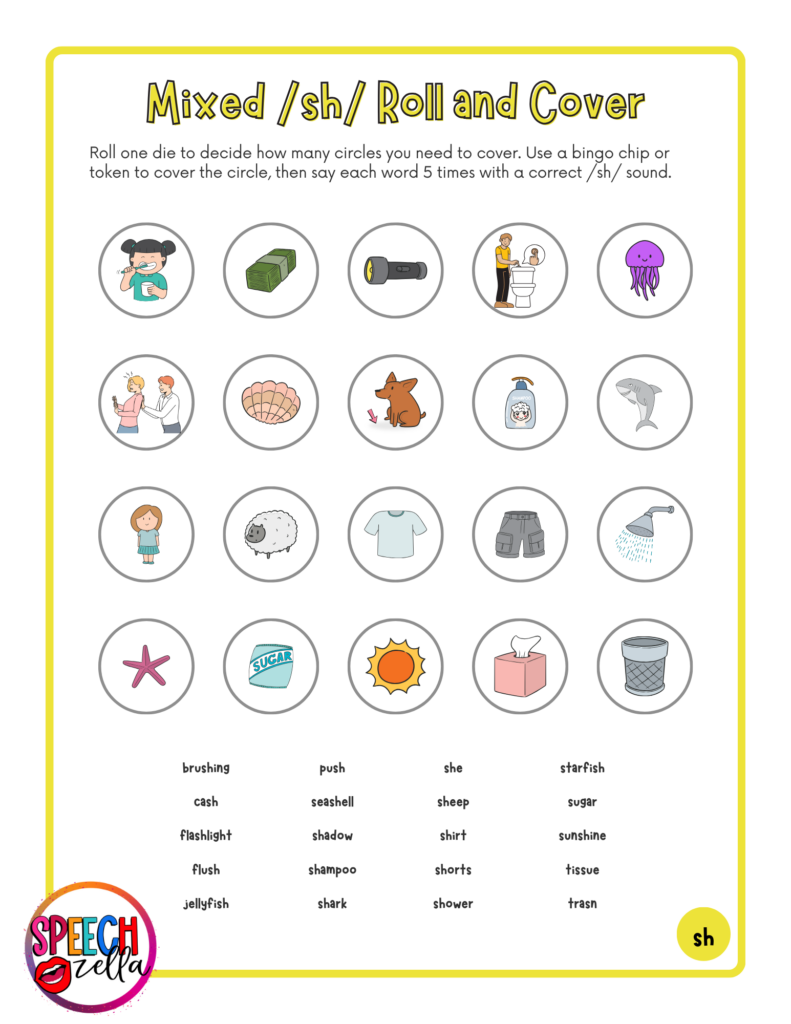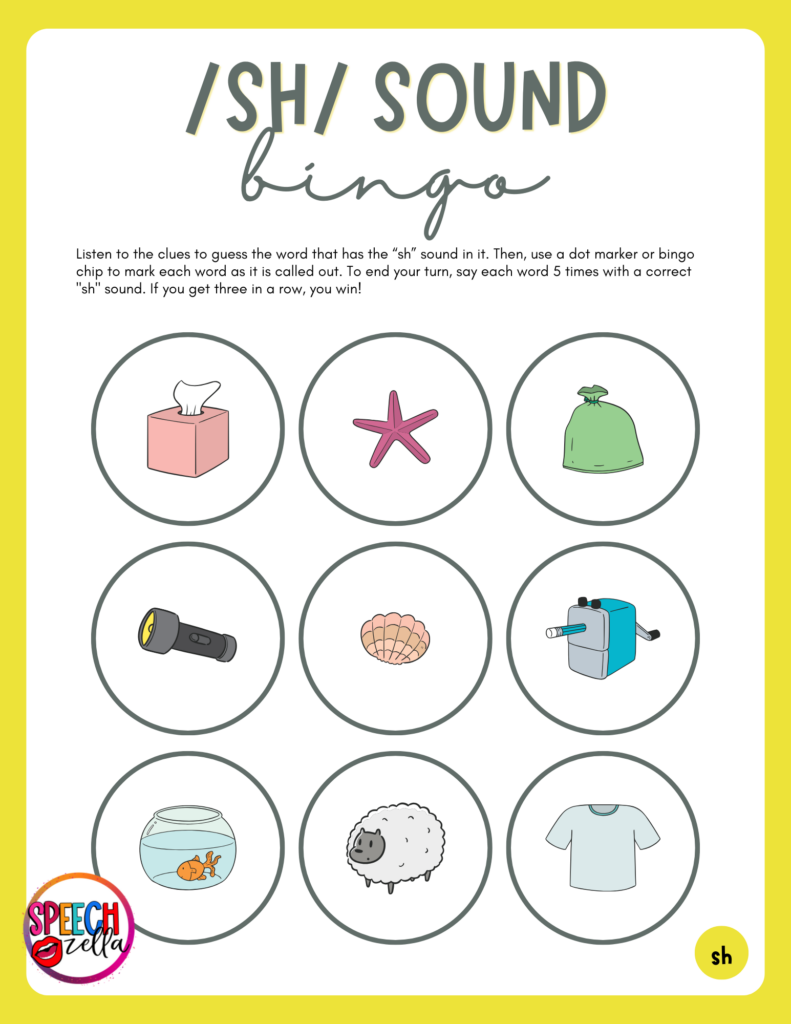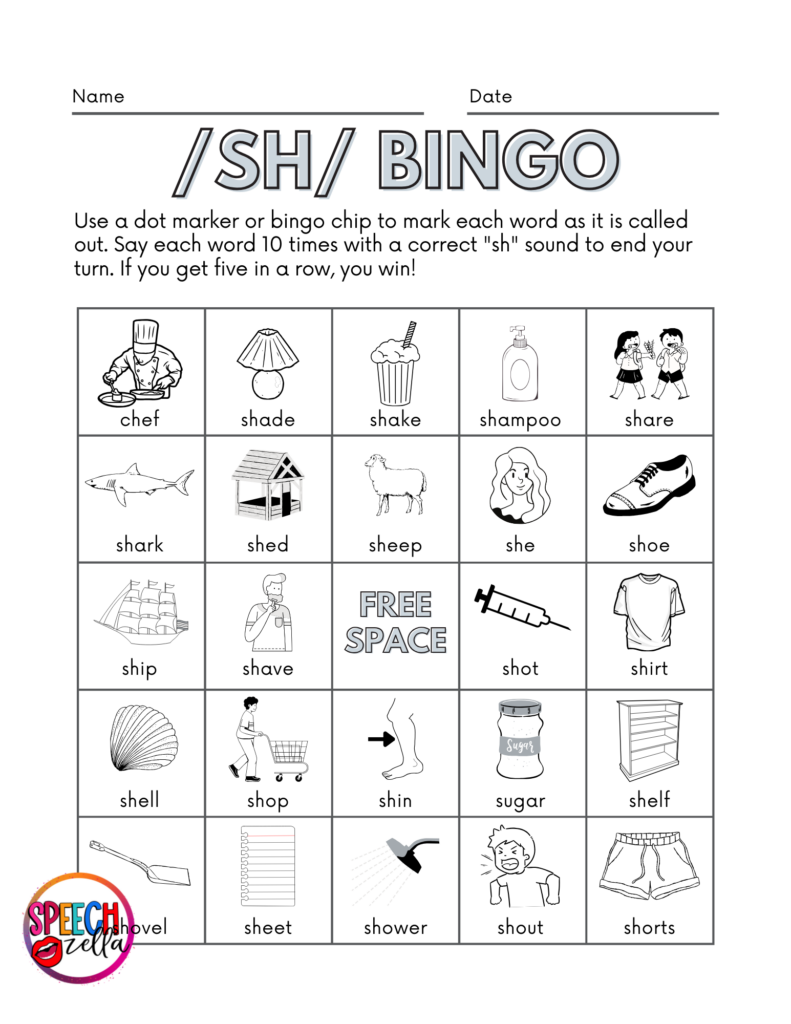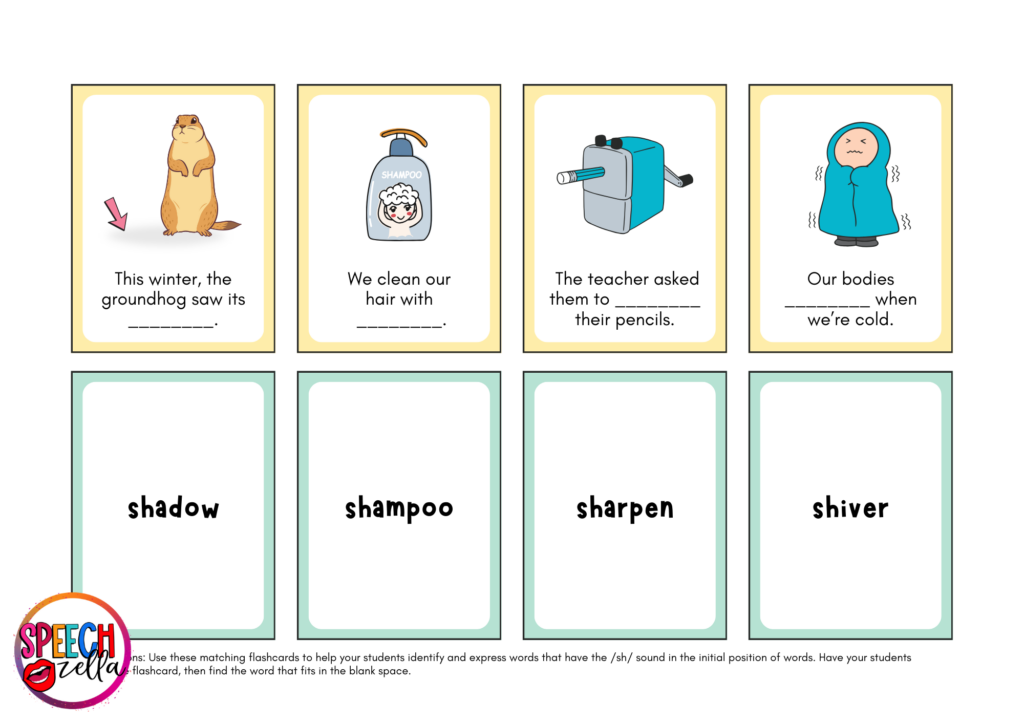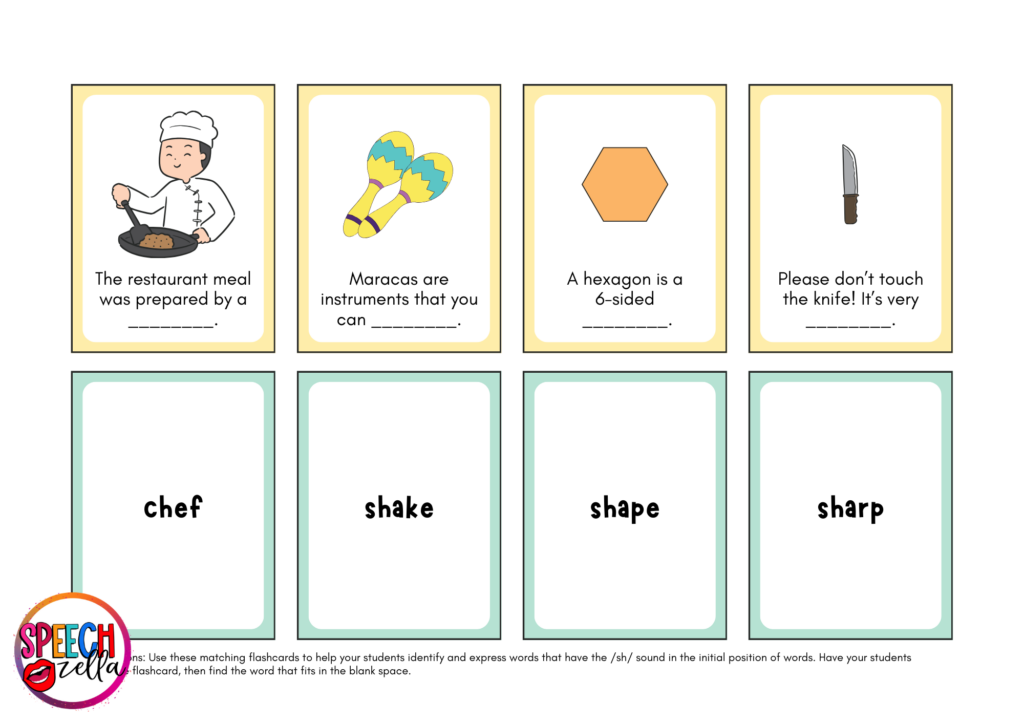Fun SH Words Speech Therapy Activities in Canva
If you’re looking for free and editable activities and worksheets to target /sh/ words in speech therapy, you’re in the right place!
I have created a set of Canva templates- including an /sh/ poster, tic-tac-toe, bingo, flashcards, and worksheets – all free with a Canva for Education account. Keep reading to learn practical strategies and find links to all the freebies.
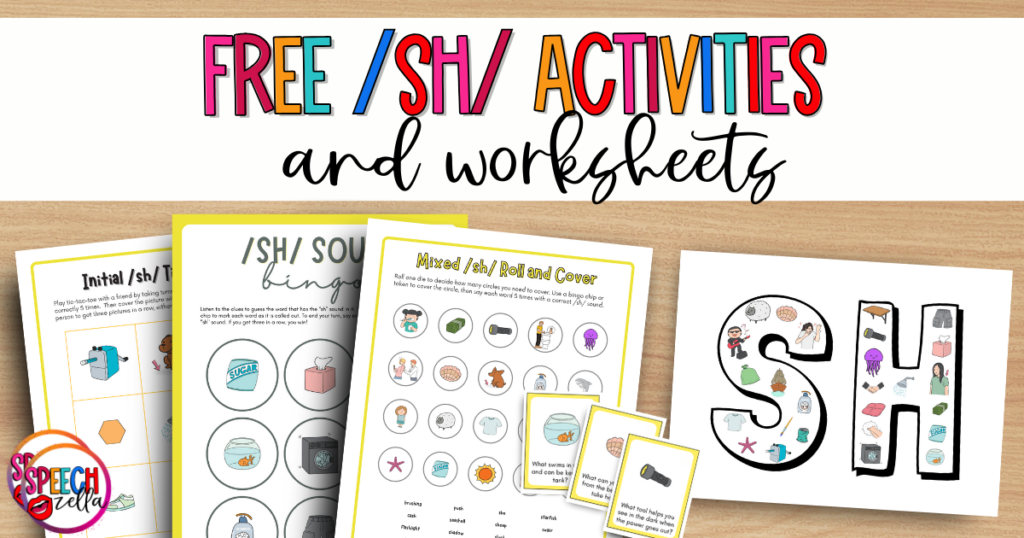
I also have a free guide for parents to the /sh/ sound for you below!
In this blog post, you’ll find all the activities I use to help my students correctly produce the /sh/ sound. As a matter of fact, I have a variety of activities that target words with /sh/ in the initial, medial, and final positions. If you want to grab the worksheets now, click on the links below!
Links to all the activities:
By combining best practices with these sh words speech therapy ready-to-use materials, you can help your students master the /sh/ sound while keeping therapy sessions engaging and stress-free.
Common /sh/ Speech Errors
Children learning to speak often encounter challenges with certain sounds, and /sh/ is definitely a sound they struggle with. Here are some common errors:
Substitutions
Substitutions happen when a kid replaces the sh sound with another sound. We usually see the following errors:
- /s/ for /sh/: Saying “sip” instead of “ship.”
- /th/ for /sh/: Pronouncing “shine” as “thine.”
- /ch/ for /sh/: Confusing “share” and “chair.”
- /t/ for /sh/: Replacing “shop” with “top”
- /h/ for /sh/: Saying “heap” instead of “sheep.”
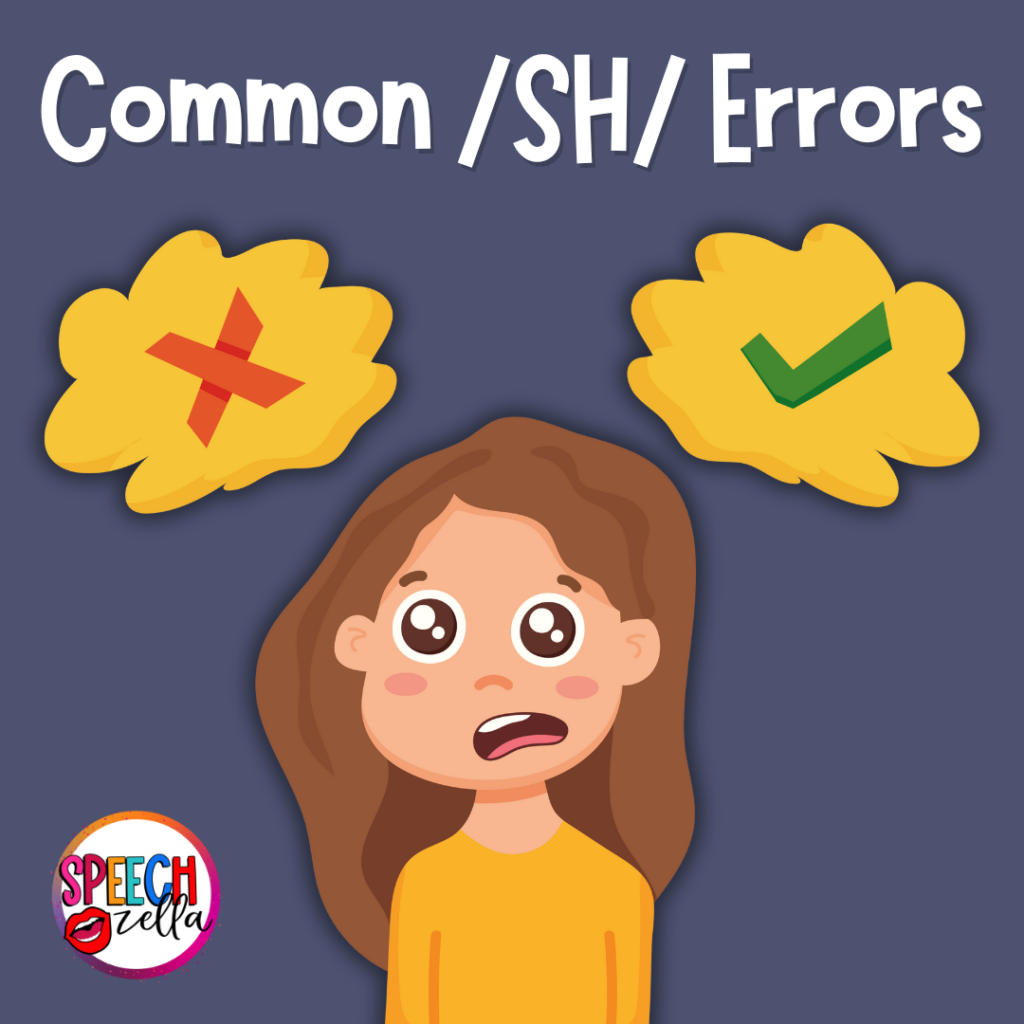
Omissions
Sometimes, a child leaves out the /sh/ sound altogether (e.g., “shoe” becomes “oo.”).
Distortions
The /sh/ sound might be produced in a distorted or unclear way. You can’t pinpoint exactly what’s wrong, but you know something’s up!
Why Is the /sh/ Sound Tricky for Some Students?
Conversely, here are some reasons why your child is struggling with the /sh/ sound.
- Motor Planning: Due to motor planning difficulties, some students can’t coordinate the rounded lips and tongue positioning needed for /sh/.
- Sound Substitution: Common substitutions include /s/, /ch/, or even deleting the sound entirely.
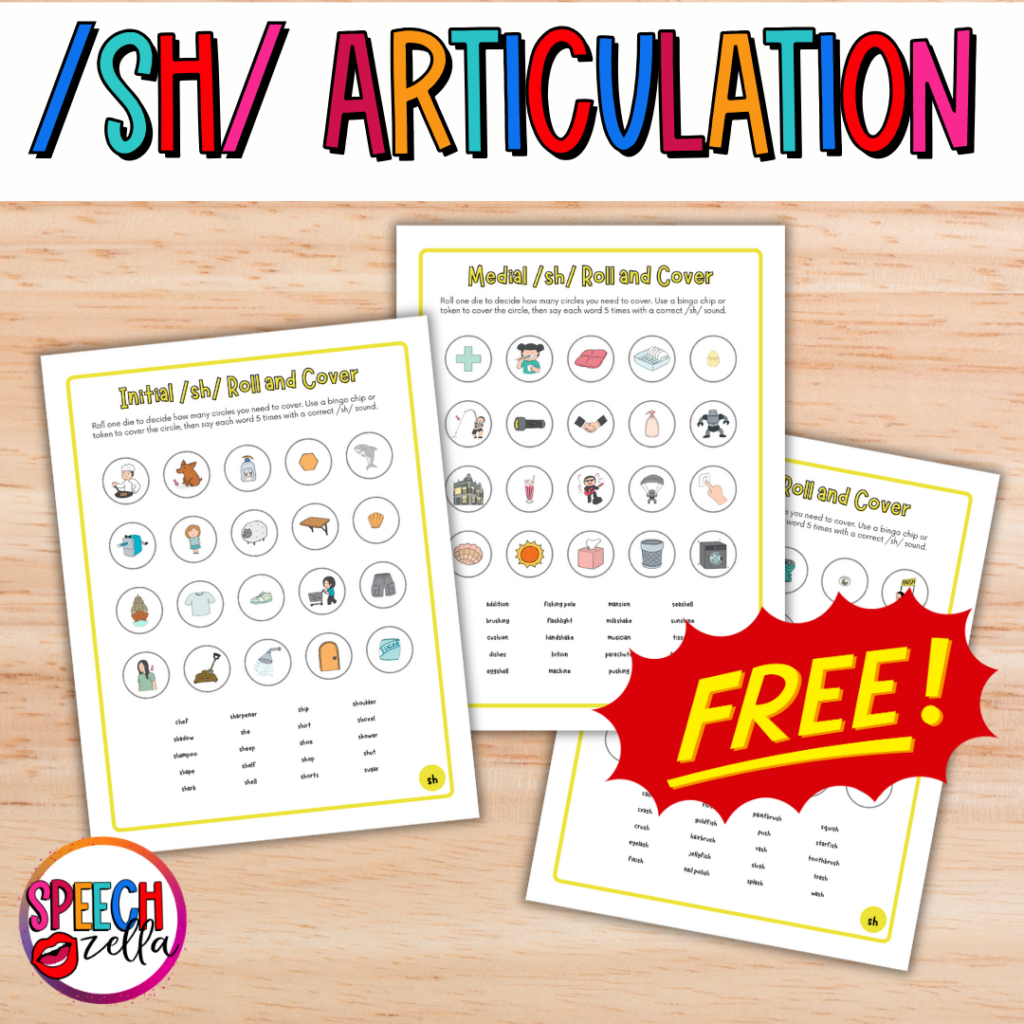
- Phonological Disorders: In some cases, students might have phonological processes (e.g., fronting or stopping) that impact /sh/. A phonological process would be treated differently (i.e., minimal pairs)!
- Auditory Discrimination: Some students can’t hear the difference between the /sh/, /s/, or /ch/sounds, in effect, making it more challenging to correct.
SH Words for Speech Therapy
The “sh” sound is a voiceless palatal fricative. If you want to make this sound, push air through your mouth with your lips slightly rounded. Keep your tongue steady and still.
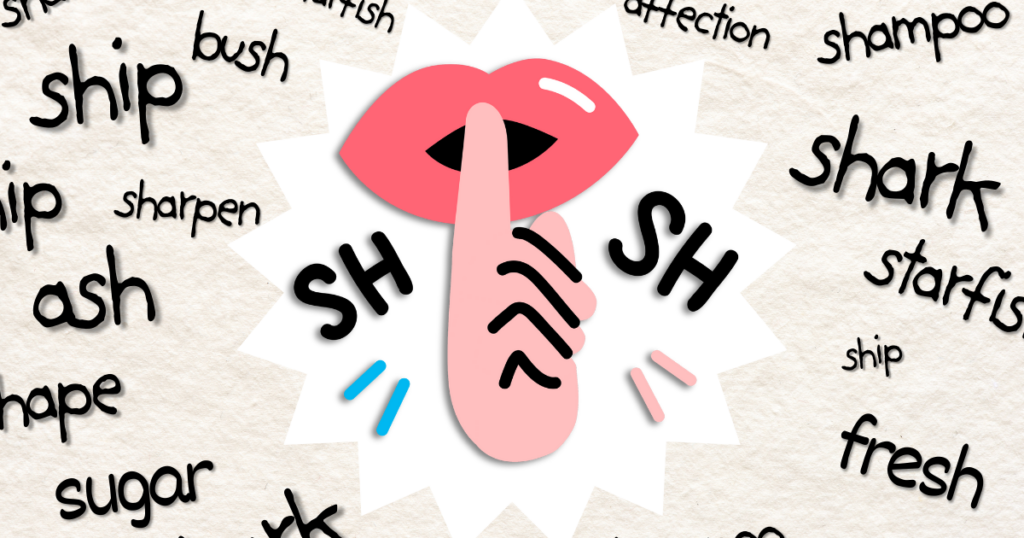
When targeting sh words in speech therapy, break them down by their placement in words—initial, medial, and final position. This can make a big difference. In the meantime, here is a list of functional words you can use today:
Initial /sh/ Words for Speech Therapy
- chef
- shack
- shade
- shake
- shape
- shark
- sharp
- she
- shed
- sheep
- sheet
- shelf
- shell
- shin
- shine
- ship
- shirt
- shoe
- shop
- shorts
- shout
- shrimp
- shut
- shy
- shadow
- shaggy
- shaker
- shampoo
- shamrock
- sharpener
- shavings
- sheepdog
- shining
- shipwreck
- shiver
- shivering
- shocking
- shoelace
- shooting (a ball)
- shooting star
- shopping bag
- shopping cart
- shoulder
- shovel
- shower
- shuttle
- sugar
Medial /sh/ Words for Speech Therapy
- addition
- barbershop
- bashful
- bushes
- brushing
- carnation
- cashews
- cash register
- cushion
- dishes
- eggshell
- flashlight
- fiction
- fishing pole
- fraction
- glacier
- handshake
- horseshoe
- lotion
- machine
- mansion
- milkshake
- mushroom
- musician
- operation
- paintbrushes
- parachute
- pushing
- seashell
- sunshine
- tissues
- toothbrushes
- trash bin
- train station
- washcloths
- washing machine
Final /sh/ Words Speech Therapy
- accomplish
- anguish
- ash
- bash
- blush
- bush
- cash
- car wash
- catfish
- crash
- crush
- demolish
- dish
- eyelash
- extinguish
- finish
- fish
- flush
- foolish
- fresh
- goldfish
- hairbrush
- hush
- jellyfish
- leash
- licorice
- mash
- moustache
- mouthwash
- nail polish
- paintbrush
- punish
- plush
- push
- radish
- rash
- rush
- scrub brush
- shellfish
- slush
- splash
- squash
- squish
- starfish
- toothbrush
- trash
- unselfish
- wash
Canva for Education
As speech-language pathologists, we always look for creative ways to make practice sessions fun. So, that’s why I use Canva for Education in my speech room daily!
Canva is a powerful, user-friendly tool that allows SLPs to edit pre-existing templates to help make learning significantly more individualized for each student.
If you enjoy creating your own materials, Canva makes it easy.
Check out my blog post to learn more about how to use Canva for Education!
How to Teach “sh” Sound in Speech Therapy
If you’re trying to explain to a student how to make the /sh/ sound, here are some tips you can suggest:
- Firstly, the sides of your tongue touch the upper back teeth.
- The middle of the tongue is raised and pulled back slightly, almost touching the roof of the mouth.
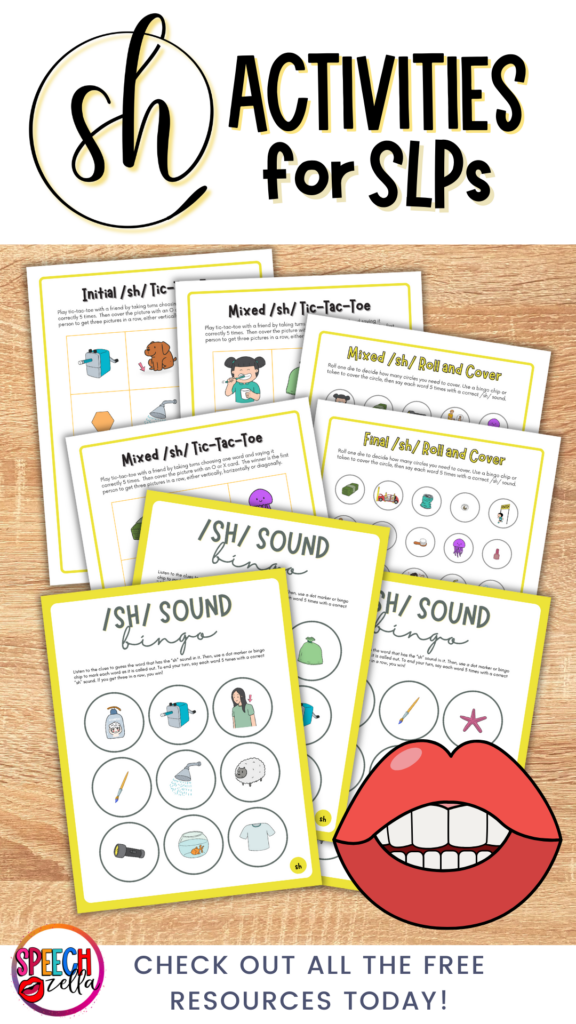
- There’s a small space in the middle of your tongue where the air flows through.
- Your lips are rounded, and you push air out.
If you need more articulation worksheets, check out my free vocalic /r/ worksheets below!
Starting with the SH sound
Speech therapy for the “sh” sound starts with simple exercises to target “sh” in isolation and then moving to more complex activities (i.e., conversation) as the child’s articulation improves.
The student must have a strong foundation, and they must correctly produce the /sh/ sound in isolation before moving on to syllables and words.
Phonetic Placement Treatment for /sh/
Here are some ways to guide students through producing the /sh/ sound:
Positioning
- Have them raise the back of their tongue until they can feel their upper teeth.
- Next, they should place the tip of their tongue just behind their upper teeth and then pull it back slightly so the tip isn’t touching anything.
- Also encourage them to round their lips and flatten their cheeks.
- Finally, have them blow air gently down the middle of their tongue.
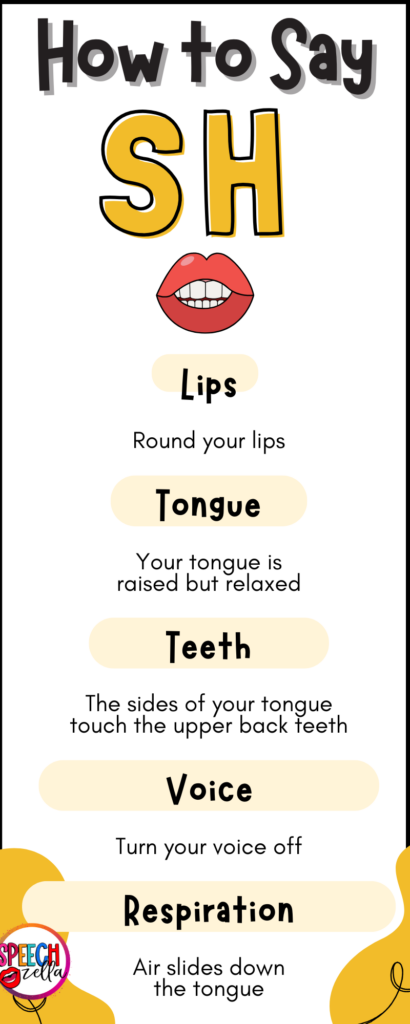
Sensory Cues:
- Gently rub the sides of their tongue with a tongue depressor, lollipop, or cotton swab.
- Ask them to place those edges against their upper teeth while blowing air across the center of their tongue.
- Lightly touch the outside of their cheek near the upper molars and tell them to keep the back of their tongue up.
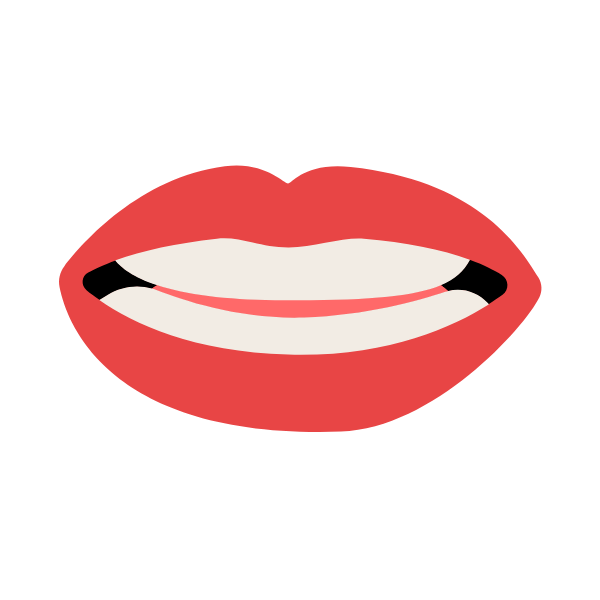
Try the spoon trick:
- Have them fit their tongue around the bowl of a small spoon in their mouth.
- Then, ask them to close their teeth around the spoon’s handle gradually.
- This helps them feel the groove their tongue needs to form.
- Occasionally, have them try making the /sh/ sound with the spoon in place.

Focus on the airstream (central airflow):
- Start by blowing air onto a target and holding their finger in front of the mouth to feel the air.
- They can also direct air toward a feather, pinwheel, or lightweight paper.
- Kids love racing, so have a cotton ball race! Tell the students to blow a cotton ball or pom pom across the table.
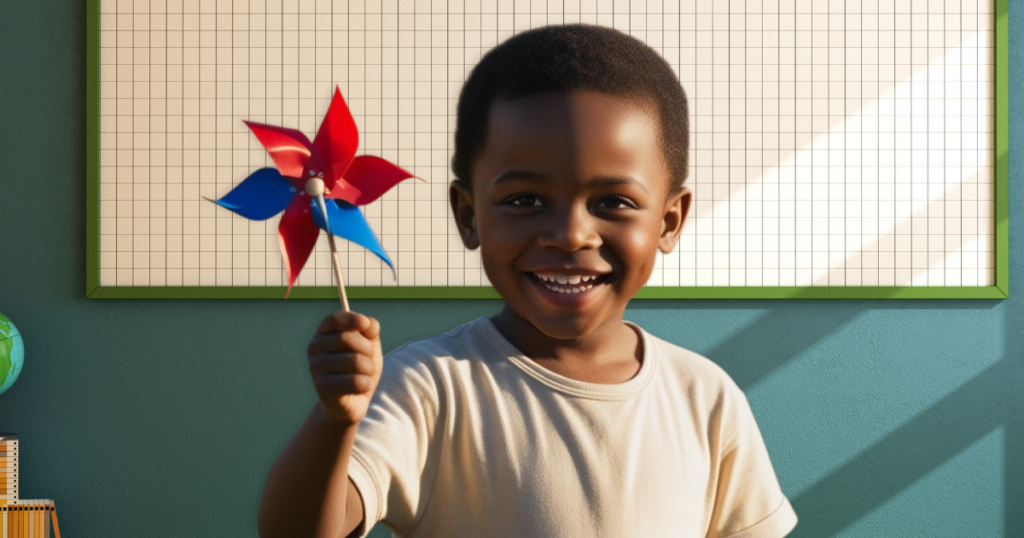
Verbal and Visual Cues
- Ask, “What do people say when they want someone to be quiet?” They’ll likely attempt a “shhh” sound. You can also use descriptions like:
- “hush sound,”
- “quiet while at the library sound,”
- “baby-is-sleeping sound.”
- Model the sound by holding a finger to your lips like a hushing gesture if needed.
- You can even describe this sound as the “slushy” sound.

How to Shape the “sh” Sound in Speech Therapy
If your student or client still struggles to say the correct /sh/ sound, you can also try shaping the sound from a sound they can say. Here are some examples:
/n/
- Ask the child to say /n/, then raise their tongue into the /n/ position.
- Then, have them pull the tongue back slightly, gently bite down, pucker their lips a bit, and blow air.
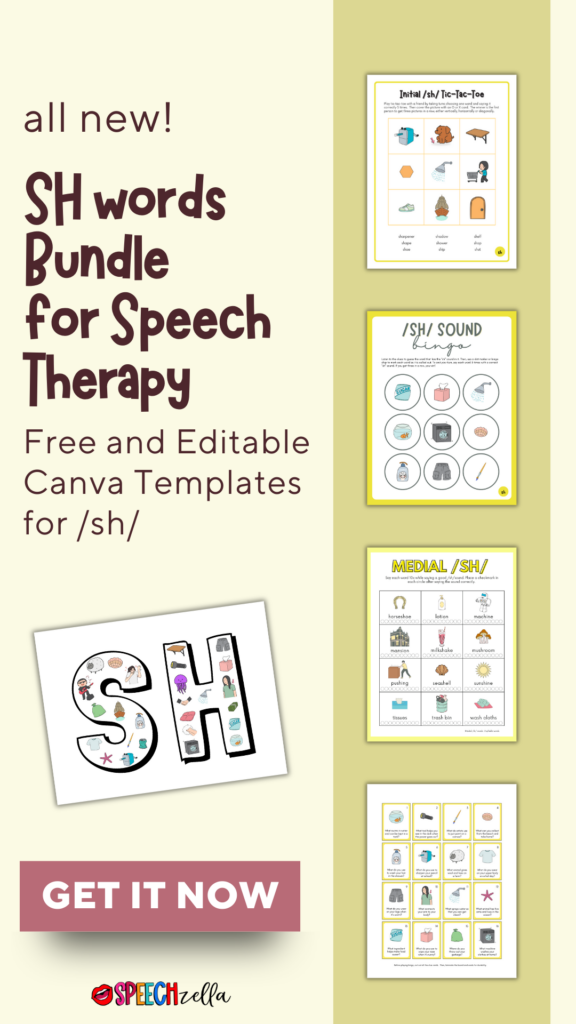
/s/
- If needed, guide their tongue movement with a tongue depressor between their teeth.
- Tell the child to prolong /s/, then pull their tongue back slightly and pucker their lips.
/ch/
- Ask the child to say /tʃ/ (as in “chip”) quickly and repeatedly, blending the sounds together until it transitions into /ʃ/ (as in “shoe”).
- Then, have them say /tʃ/ slowly, focusing on rounding their lips during the /ʃ/ part of the sound.
Where to Start Teaching the /sh/ Sound
Firstly, start with easier words, like words where /sh/ is at the beginning.
As they get better, move on to words with /sh/ at the end of the word and then in the middle (which is more difficult). Also, using pictures or color-coding can help them connect the sound with its spot in the word.
Using my Canva templates, you can tailor your word lists and adapt your therapy for each student’s needs. For instance:
- With younger students, focus on high frequency, everyday words (e.g., shoe and fish).
- For older students, incorporate more complex or academic vocabulary, such as social or caution.
Learn how to make adapted books for your autistic students in my other blog post Adapted Books for Autism:
Sh Words Speech Therapy Worksheets
In Canva, I have three worksheets where you can make word lists with pictures to match each word, making practice easy.
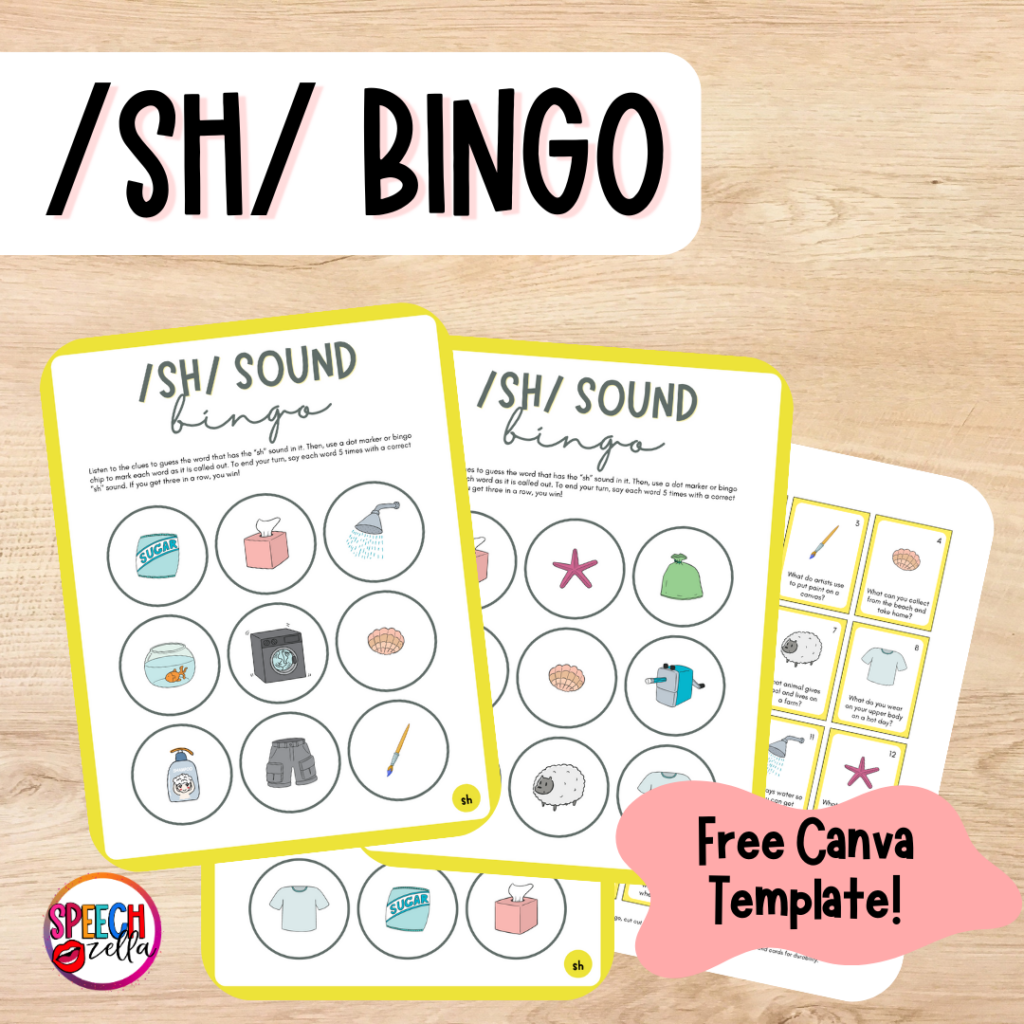
These can be printed out for in-person sessions or shared digitally for teletherapy.
*Personalize these in Canva, but please note that these activities are for personal use only.*
Please refer to Canva’s terms of use to understand more about selling Canva templates.
Drill Based Worksheets:
These worksheets can be printed in color or B&W, so making them a great resource for targeting the /sh/ sound.
The student has to say each word using the correct /sh/ sound and then mark off a circle. By the end of the worksheet, they’ll have practiced the /sh/ sound 90 times.
How to Use Them:
- Use the words as prompts when working at sentence levels, e.g., “The shark is swimming.”
- Print 2 copies of each page. Then, cut the words into smaller squares and play a memory-matching game.
- Swap out the pictures directly in Canva and make sure they look exactly like you want before printing.
Tic-Tac-Toe Worksheets
Each square on the tic-tac-toe board includes an /sh/ word. Students practice saying the words correctly and then cross off items as they go, aiming to complete a row, column, or diagonal to win the game.
These worksheets target the /sh/ sound at the word level.
How to Use Them:
- Encourage word repetition as students say each word in the square.
- Add an extra challenge by asking students to use the word in a sentence before marking the square.
- Use for partner practice, where one student plays against another, ensuring collaborative learning.
Why They Work:
- Students love the game format, which encourages them to repeat the sound in a low-pressure environment.
Roll and Cover Worksheets
These worksheets combine articulation practice with a fun dice-rolling game to keep students engaged while working on the /sh/ sound.
How to Use Them:
- Available in color and black and white.
- Students roll a die and then choose the number of images that match their die.
- Then, they say the /sh/ word associated with the image aloud 5 times.
- The student covers the image with a marker, chip, or small token when the word is said correctly.
- Play continues until all images are covered or for a set time limit.
Why They Work:
- The element of chance adds fun and, secondly, keeps students motivated.
- Because repetition is naturally built into the activity, this is a great way to reinforce the target sound.
/sh/ Bingo Game
Bingo games are a fun, engaging way to practice /sh/ sounds in different word positions (initial, medial, and final).
Each square contains an /sh/ word with a corresponding calling card with a short clue (e.g., “What ocean animal has sharp teeth and is a fierce predator).
I have two versions that you can check out, so get them today!
How to Use Them:
- Download the bingo boards, as well as the calling cards as a PDF.
- Print, cut, and then laminate all the calling cards.
- Call out /sh/ words, and students mark the corresponding square.
- For added challenge, students can create sentences using the /sh/ word before marking the square.
- The first student to complete a row, column, or diagonal wins!
Why They Work:
- Bingo adds a game element to therapy sessions so students are motivated and engaged.
- It’s adaptable to group or individual settings, making it versatile.
/sh/ Flashcards
Matching flashcards is also a great way to help students practice the /sh/ sound in isolation, words, and sentences. Because of this, they’re ideal for various learning styles and therapy settings.
How to Use Them:
- Download, print, and then laminate all the flashcards.
- These flashcards can also be used as a matching game or for drilling the /sh/ sound.
- Lay the cards face-up for beginners to match words with pictures. You can even place the cards face-down for a memory-style game instead.
- For added practice, you can also have students say the /sh/ word out loud as they make matches or use it in a sentence.
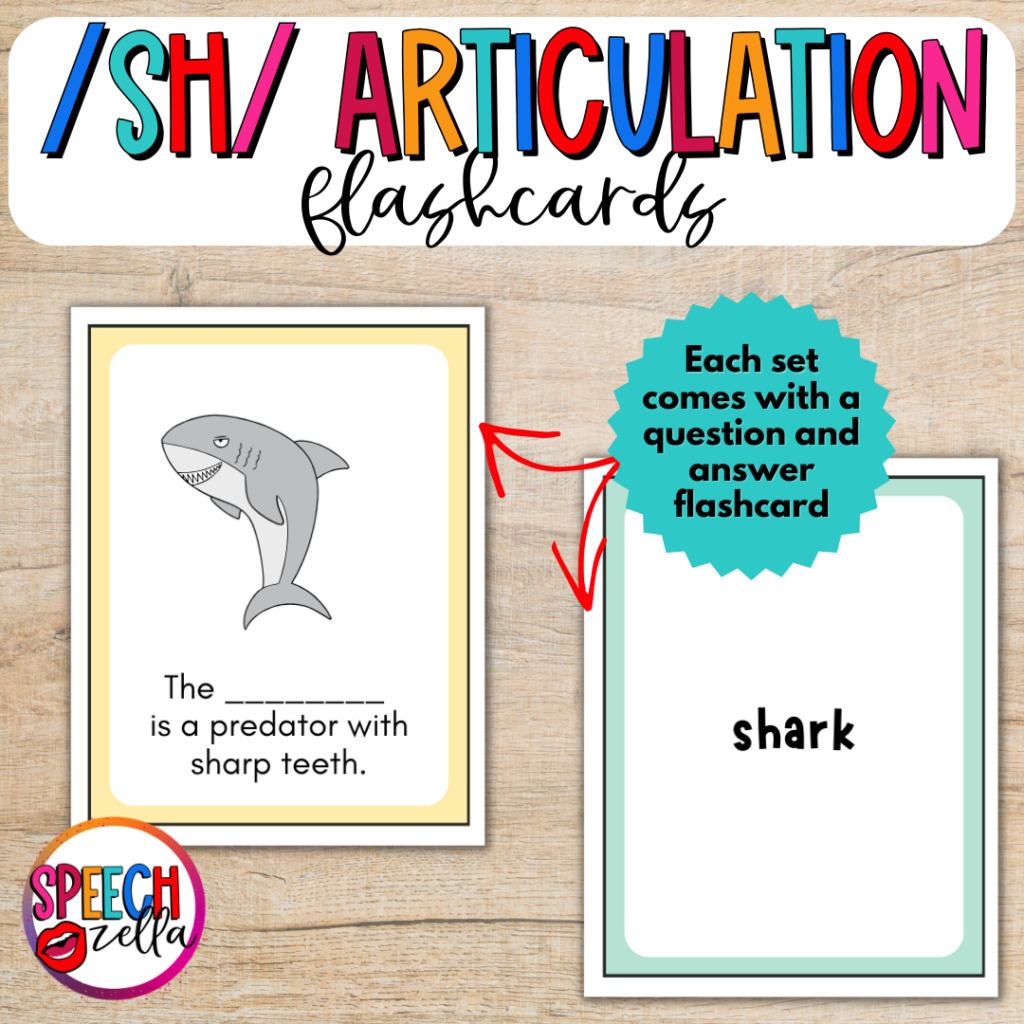
Why They Work:
- The visual support helps students connect the sound with its meaning, especially for younger learners.
- Repetition through matching reinforces articulation practice in a fun, low-pressure way.
- They engage multiple senses, making learning more effective and enjoyable.
Additional Engaging Activities:
- Sorting Games: Separate flashcards into categories (e.g., initial, medial, final /sh/) and have students practice each group.
- Sentence Building: Use flashcards to create simple sentences (e.g., “The shark is swimming.”).
- Speed Challenge: Time students as they match all the cards to add excitement and encourage quick recall. Make sure you give them enough time!
- Storytelling Prompts: Have students pick three random flashcards and create a short story using the /sh/ words.
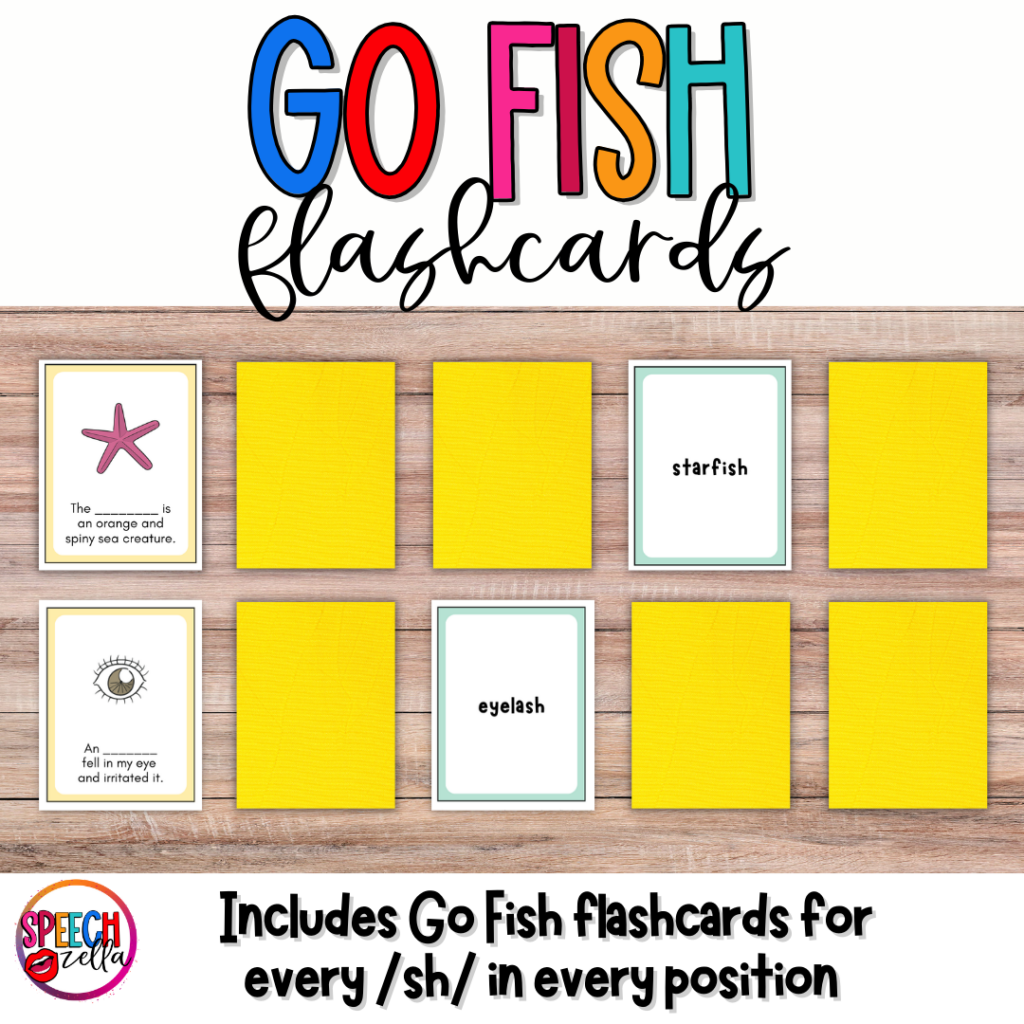
Interactive /sh/ Poster
One of my favorite tools is this sh/ sound poster. It includes both an “S” and an “H,” with images of /sh/ words in initial, medial, and final positions inside the letters.
How to Use It:
- I Spy Activity: Have students search for and name all the /sh/ words hidden within the poster.
- Word Sorting: Ask students to identify whether each word is in the initial, medial, or final position and sort them accordingly.
- Visual Reference: Display the poster in your therapy room as a quick visual cue during sessions.
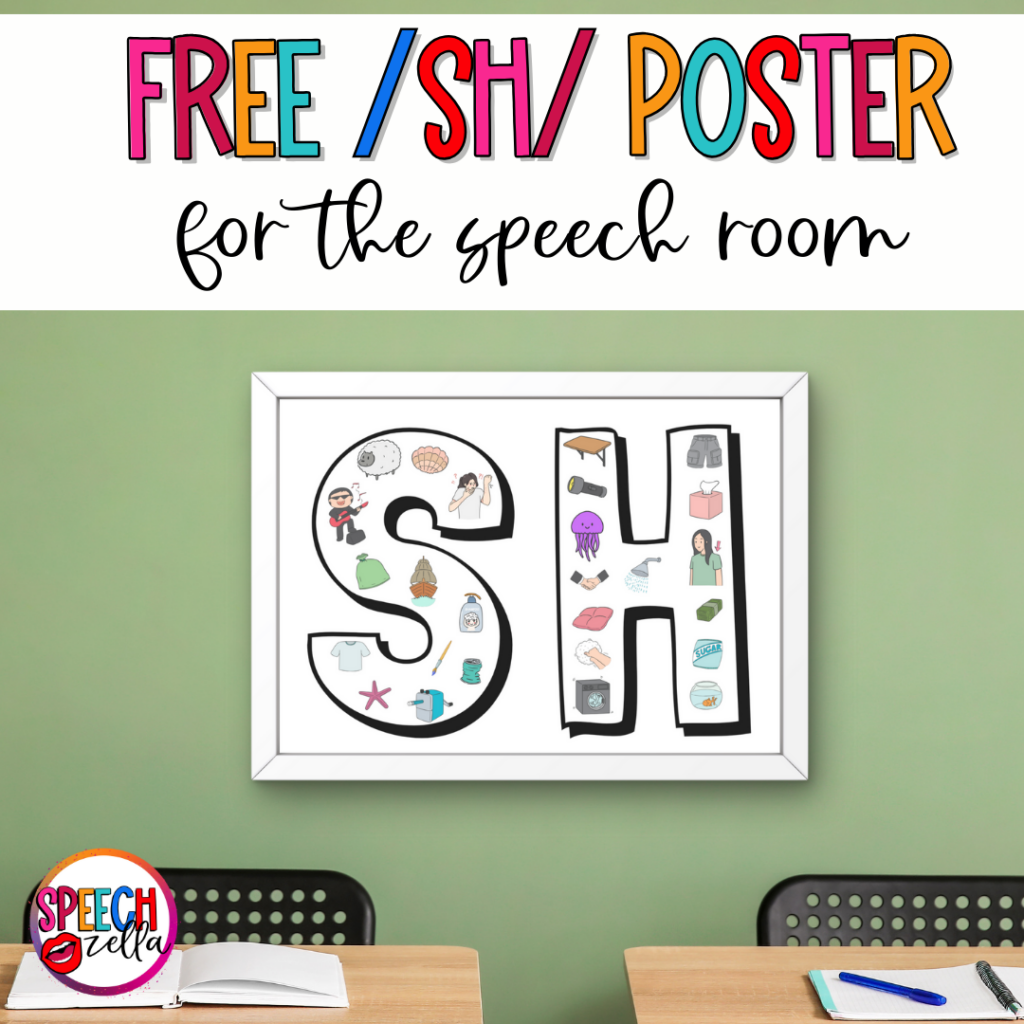
Why It Works:
- The combination of visual and interactive elements keeps students engaged.
- It can also be used for independent work or group activities, making it a versatile tool.
Additional Activities:
- Word Discovery: Ask students to write sentences using the words they find.
- Art Integration: Then, let students color in the poster as they practice each word.
- Memory Game: Play I Spy. Afterward, remove the poster and challenge students to recall as many words as possible.
/sh/ Infographic
Similarly, visual aids like infographics can help students (and parents) understand how to produce the /sh/ sound.
For example, here is an infographic you can use in your social media posts or hang up in your speech room.
How It Works:
- For one thing, this infographic breaks down the steps to create the /sh/ sound.
- The steps involved in making a good /sh/ sound are included (e.g., round your lips, and turn off your voice).
- The poster also includes an image of the mouth producing the /sh/ sound.
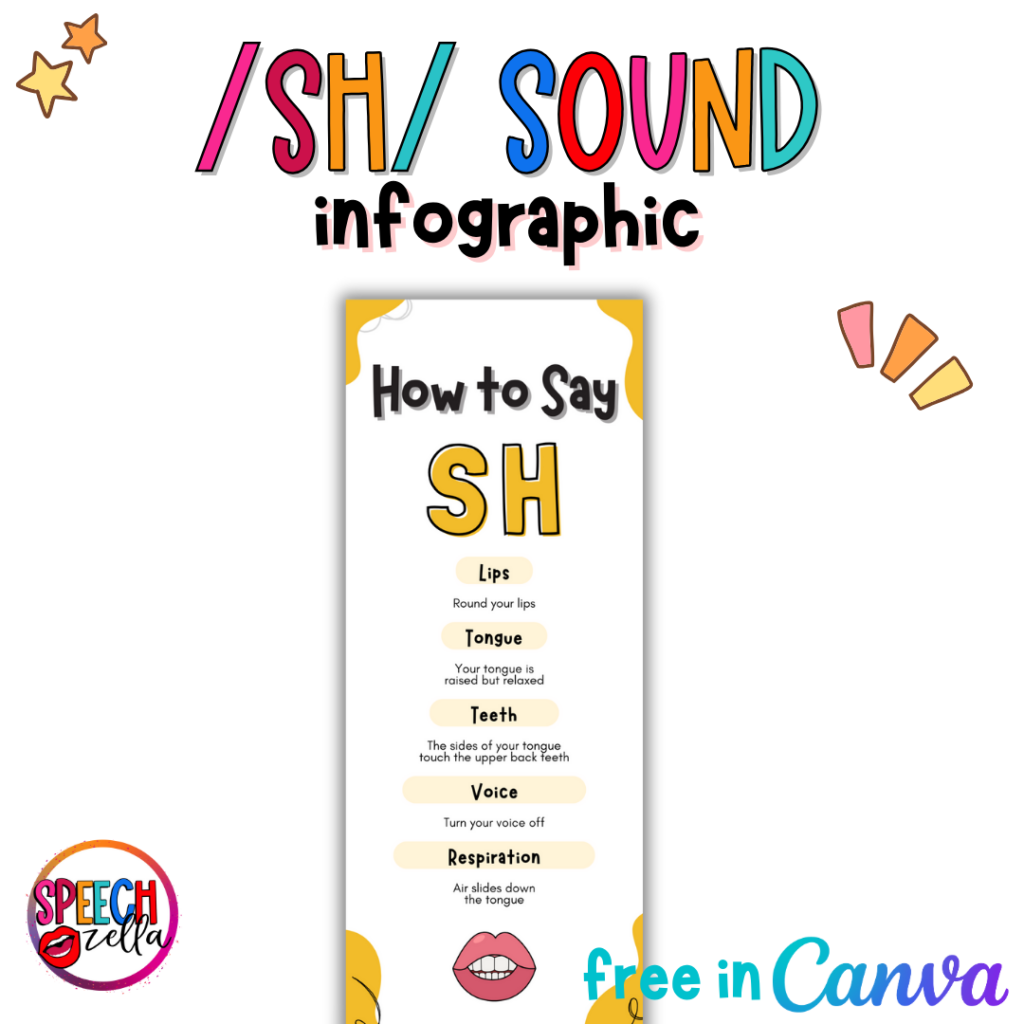
Why It Works:
- Gives students a visual reference they can revisit during practice.
- Helps parents also reinforce practice at home.
- Simplifies complex articulation concepts into small steps.
By following this step-by-step guide and incorporating Canva-based resources, SLPs can ensure students receive comprehensive, engaging support as they master the /sh/ sound.
Lastly, make sure you check out all the free resources today!
Freebie Resource Library for SLPs
If you want to get access to all of my free resources, make sure you sign up for my newsletter! You'll get immediate access to all the freebies in my free resource library.
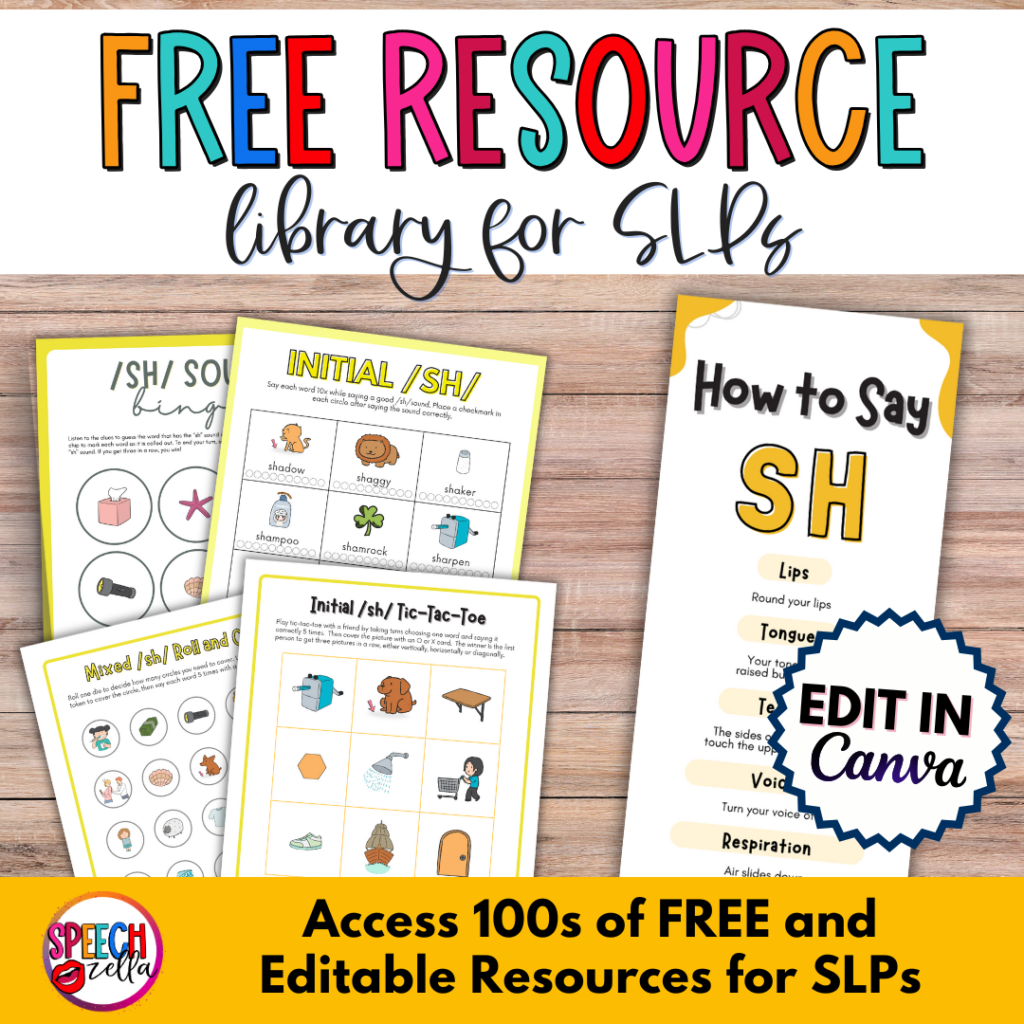
Why Speech Therapy for /sh/? (Parent’s Guide)
If you’re a parent of a child struggling with how to say the /sh/ sound, here is some information so you can get your kid the right help.
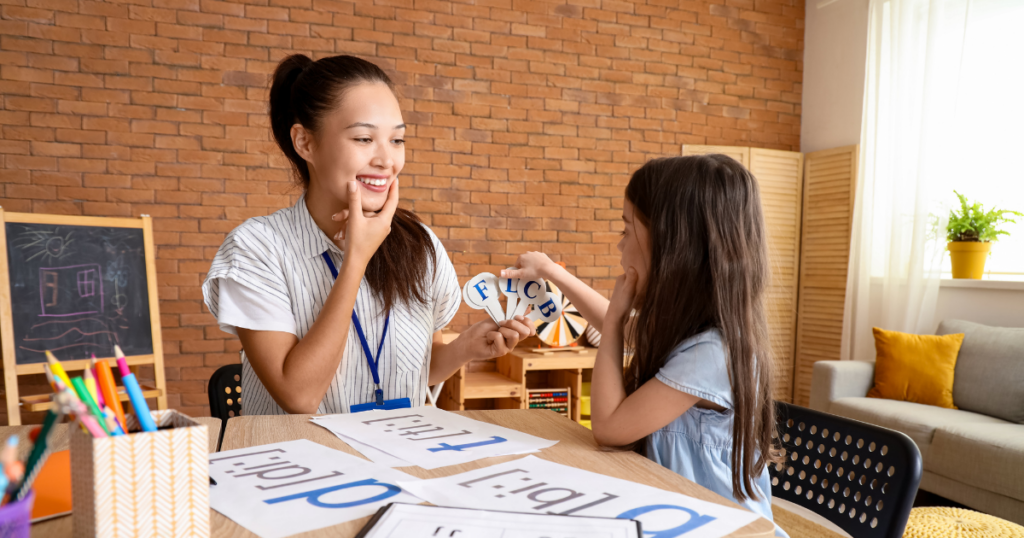
Who does speech therapy?
A speech-language pathologist (SLP) is a specialist who can evaluate and treat language and sound disorders (e.g., expressive language, articulation, etc).
An SLP has had years of speech and language development training before becoming certified to help students with an articulation disorder (i.e., producing sounds correctly).
SLPs work with people with articulation disorders, whether infants or older adults.
If you want to learn more about the difference between speech and language, check out my other blog post The Difference Between Speech vs Language Disorders:
Where do speech therapist work?

SLPs can work in various settings, including school districts, hospitals, rehabilitation centers, nursing homes, and private practice.
If you’re looking for a qualified speech language pathologist to help your child, ask your pediatrician for a referral.
Additionally, you can find a speech therapist in your state via the ASHA ProFind hub, which lists all the professionals accepting referrals.
If your child’s articulation skills negatively affect their academics in the classroom, you can speak to the speech pathologist at the school directly to see if they qualify for services in your school district.
When Should Speech Therapy Start?
Early intervention is key! Young children often encounter difficulties with the “sh” sound, frequently substituting it with other articulation sounds like “s” (e.g., “sip” for “ship”) or “ch” (e.g., “chut” for “shut”).
According to the American Speech-Language-Hearing Association (ASHA), children acquire the /sh/ sound by 3 ½, but some may not master it until they are 7.
Therefore, early speech therapy is important to address this difficult sound and help students develop the “sh” sound.
Why Speech Therapy is Important
When a student or child can’t produce the /sh/ sound, they might struggle with intelligibility (the ability for others to understand their speech), which makes it difficult for their peers and teachers to understand them.
If the student feels confident with the way their speech sounds, they’ll want to participate more in classroom discussions or with peers.
As I have said, speech therapy is definitely worth it!
How Speech Therapy Works
Lastly, speech-language pathologists (SLPs) use various techniques to help kids learn how to make the “sh” sound. Specifically, some of these techniques include:
- Auditory Discrimination: Helping kids tell the difference between the “sh” sound and other similar sounds through listening activities and games.
- Oral Motor Exercises: Strengthening the lip, tongue, and jaw muscles needed to make the “sh” sound through special exercises.
- Placement: Teaching kids where to put their tongue, teeth, and lips to make the “sh” sound above all.
- Repetition and Home Practice: Giving kids lots of chances to practice the “sh” sound in different ways, such as by itself, in syllables, words, phrases, and sentences. The SLP might also assign homework to help improve the target sound.
- Play-Based Activities: Making the “sh” sound part of fun activities, such as games, stories, and songs, to keep kids motivated and interested.
If you want more articulation and language worksheets, get access to my freebie resource library!
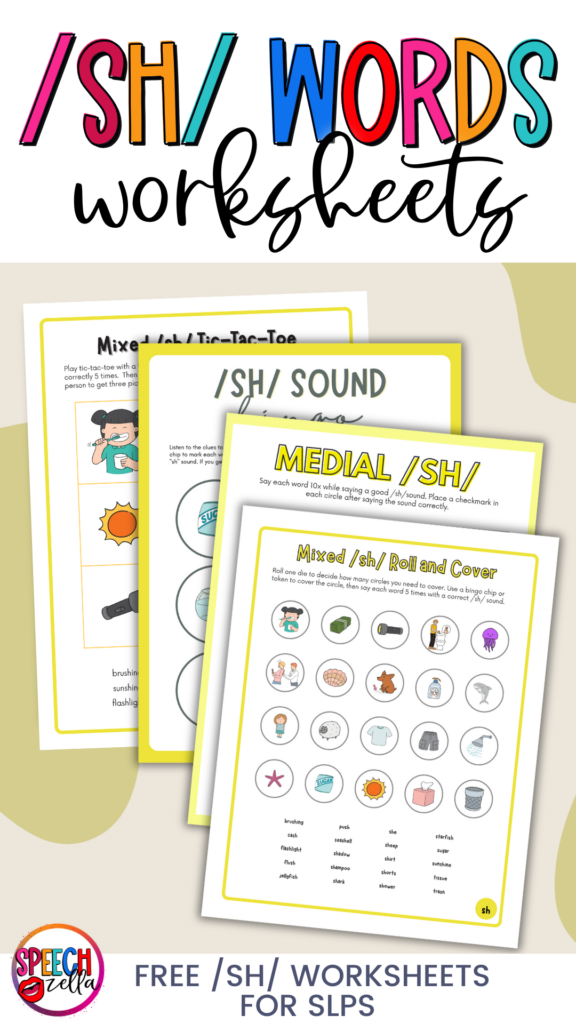
Improving a child’s ability to say the /sh/ sound can also positively impact their language skills!
If you want more information about Canva, speech therapy, articulation therapy, or sound production, send a message to my email address or leave a comment below!

